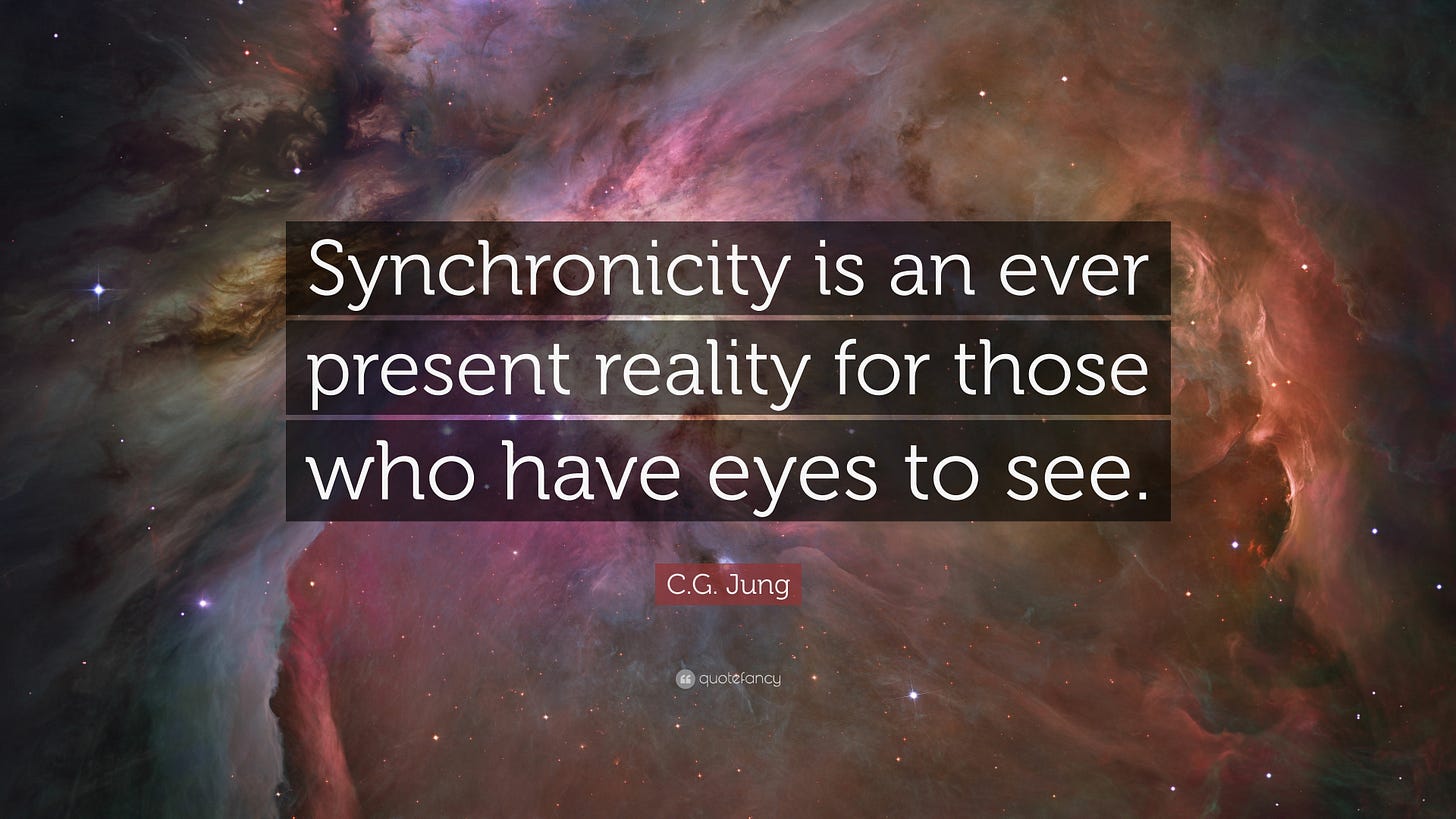Life tends to surprise you with uncanny moments of alignment. The times you end up stumbling upon the person or the right thing at just that point of circumstance in your life—or at times you get the answer to a lingering question at a place you weren’t expecting. This phenomenon is what Carl Jung called synchronicity; he called it meaningful coincidences between events that seem unrelated.
You might ask yourself questions like:
“What are the odds of that happening right now?”
“Wow, I was just thinking about this very thing, and here is a sign related to it!”
“I needed to hear that message—how fitting that it came across my path today!”
Could it, maybe, be more than just a psychological phenomenon? What if it mirrors something as incredibly deep at the fabric of reality itself as quantum physics posits? Where does synchronicity come from if it is from the quantum realm, and what is it telling us about the interconnectedness of all things?
Synchronicity: The Basics
For Jung, synchronicity was an 'acausal connecting principle', events having no cause and no effect but sharing a 'common underlying meaning'. As an example, you may see a rare bird in your dream and that same rare bird appears the next day in an unusual place. Though no one has a direct cause and effect between the dream and the sighting, their alignment somehow feels profound, like consciousness is just telling you something.
To Jung, synchronicity wasn’t random. It has come from the collective unconscious, the deepest level of what we share collectively, experiences of archetypal patterns. What could this possibly have to do with the world of quantum mechanics?
The Quantum Perspective on Interconnection
What lies at the heart of quantum physics is the principle of entanglement: two particles can become entangled, to the point that their state can influence the other instantaneously, regardless of the distance between them. This came to be called ‘spooky action at a distance’ by Einstein. Synchronicity and quantum entanglement are two different things, but both show that we experience a universe that is deeply interconnected in ways that defy classical logic and reasoning.
Quantum theory also includes a theory of a probabilistic reality. Whereas in classical mechanics the law of causality prevails—cause and effect—or at least, the semantic appearance of it—the case in quantum mechanics is probabilities and potentialities until observation, in which these are collapsed into a single result. The result of this is that a world of outcomes that appear random is a world defined by hidden patterns.
Is there some hidden quantum layer that could underlie synchronicities: entanglement and probabilistic outcomes can yield meaningful alignments in our everyday lives?
Synchronicity as a Quantum Phenomenon
While science has yet to definitively link synchronicity with quantum mechanics, there are intriguing parallels:
Nonlocality and Interconnectedness: At a fundamental level, according to quantum entanglement, everything might be connected — everything. From this universal interconnectedness might arise synchronicities, or patterns that bring on the bridging of inner thoughts and outer events.
Observer Effect: Quantum physics is all about the importance of the observer in determining what becomes reality. In like manner, we become aware of such synchronicities at the same time they tend to emerge more clearly. How these meaningful coincidences occur may depend upon the act of noticing.
Emergence from the Quantum Field: The quantum field theory supposes that the unified field is from all particles and energy. Maybe there is a ripple or a certain resonance in this field, where inner intentions and outer circumstances momentarily align into a synchronicity.
The Role of Intention and Consciousness
One of the things that is most fascinating about synchronicity is that it seems to respond to intention. What you experience in terms of synchronicities is stronger if they are meaningful to a goal you have, when you are very much focused on it and deeply immersed in a process of significant personal transformation. That is by the idea that consciousness actively shapes reality, an axiom that has been considered also in quantum theory and spiritual traditions.
For instance:
Law of Attraction: It could also be interpreted that the universe works out events in response to our thoughts and intentions.
Meditation and Mindfulness: It is said to increase synchronicity with these practices, which help tune us to the quantum field better.

Practical Applications of Synchronicity in Quantum Reality
Whether or not synchronicity has a quantum explanation, it offers practical insights into how we navigate life.
Follow the Patterns: Look for repetition of symbols, numbers, or themes in your life. However, these may be signals leading you deeper into truth or more unacknowledged desires.
Align Your Intentions: Start with setting clear intentions and see how synchronicities manifest and align with your goals; it’s as if everything is reacting to your momentum and focus.
Trust the Process: Synchronicities help to remind us that not all things are random. Trust in these moments could provide confidence and boost your creativity in challenging times.
Conclusion: Synchronicity as a Bridge
Synchronicity suggests that the veil between the scientific and the spiritual is thin, calling us to see reality as an intricate dance of connections. No matter if it’s from the quantum realm or the collective unconscious, it encourages us to embrace the mystery of life and our role within it. Observing and acknowledging these moments occur has the potential to lead us to a deeper blueprint: a quantum and cosmic blueprint, moving between the visible and the unseen.
Are you noticing synchronicity in your life? What synchronicities formed in your way? Leave your thoughts below; I’d love to hear what you’ve experienced.






This is fascinating to me. I've experienced some seemingly minor synchronicities, but I feel I need to lean into them and set my mind on a specific goal to see how (and if) the universe moves to help me. Do you have any notable experiences?
Really interesting. And I am forever seeing 11.11, so that was an added bonus too.